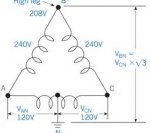TBotNik
Member
- Location
- Greenville, TX
All,
Looked all over the internet and can not find what I'm looking for to correctly calculate my amperage for this xfmr and the 120/240 breaker panel main breaker rating, so I spec everything right for the electricians. What I have is a new computer room with 300 computers @ 120/240 VAC 6.5 continuous amps. I additionally have 7 data switches @ 120VAC 2 continuous amps, an HVAC blower unit @ 240VAC 3 phase 15 amps and per conversation with the client need 20-30% expansion for other laptops, fans, monitors, etc that will be utilized in the room.
What I'm missing in my formula is the distribution factor across the 3 phase. I'm aware of the 1.75 multiplier, but not sure that is the right way to calculate my formula. I also looked in the NEC and find no table or calculation for this, unless I'm not knowing where it is and recently completed the course, and this was not covered there either.
Anyway my total load in Watts is 384,960 or 385KW,
If I use the logic on balancing this load across 3 legs of LPL=TL/3 (load per leg = total/3) I get 1080 amps per leg, but using LPL=TL/1.75 I get 1842. I've ordered the complete computer spec sheets as this just does not seem right and thinking what the company sent me is startup amps, not continuous. Anway a breaker panel with a 2,000 amp breaker just does not sound right and the step-down XFMR to support it also sounds bizare, but need input on if I'm doing these right.
With current calculations I need the fused switch in the 480VAC 3phase MDP of either 400 or 700 amps, so all is critical here.
Thanks in Advance for all your help!
Cheers!
TBNK
Looked all over the internet and can not find what I'm looking for to correctly calculate my amperage for this xfmr and the 120/240 breaker panel main breaker rating, so I spec everything right for the electricians. What I have is a new computer room with 300 computers @ 120/240 VAC 6.5 continuous amps. I additionally have 7 data switches @ 120VAC 2 continuous amps, an HVAC blower unit @ 240VAC 3 phase 15 amps and per conversation with the client need 20-30% expansion for other laptops, fans, monitors, etc that will be utilized in the room.
What I'm missing in my formula is the distribution factor across the 3 phase. I'm aware of the 1.75 multiplier, but not sure that is the right way to calculate my formula. I also looked in the NEC and find no table or calculation for this, unless I'm not knowing where it is and recently completed the course, and this was not covered there either.
Anyway my total load in Watts is 384,960 or 385KW,
If I use the logic on balancing this load across 3 legs of LPL=TL/3 (load per leg = total/3) I get 1080 amps per leg, but using LPL=TL/1.75 I get 1842. I've ordered the complete computer spec sheets as this just does not seem right and thinking what the company sent me is startup amps, not continuous. Anway a breaker panel with a 2,000 amp breaker just does not sound right and the step-down XFMR to support it also sounds bizare, but need input on if I'm doing these right.
With current calculations I need the fused switch in the 480VAC 3phase MDP of either 400 or 700 amps, so all is critical here.
Thanks in Advance for all your help!
Cheers!
TBNK

